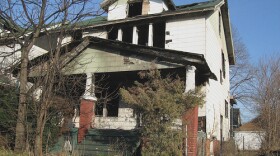This week, Changing Gears kicks off a look at Empty across our region. During November, we’ll be looking at empty buildings, empty property — and how we can fill things up again.
In the first part of our series, I explore the economic and social cost of emptiness.
Things may be better in some neighborhoods, but problems still abound.
The numbers
There is no one number that tells the story of all the empty houses, storefronts, offices and factories in the Midwest. But there are many numbers that tell part of the story.
Like this: One out of ten.
One out of ten homes in Illinois, Indiana, Michigan, Ohio and Wisconsin was vacant in 2010. That’s according to the U.S. Census.
Or these numbers:
Twenty-two percent of office space in the Cleveland area is empty.
Chicago offices are 19 percent empty.
Metro Detroit: almost 27 percent.
Those numbers are from the real estate firm Grubb & Ellis. Fred Liesveld from the firm’s Detroit office says those numbers have actually been getting better for almost a year. He said of the 27 percent vacancy figure: “We haven’t seen that in a decade. That’s just great news.”
And really, there’s a lot of good news in the Midwest.
In every city there’s at least one neighborhood that used to be a lot worse.
Positive signs in West Michigan
Where I live in Grand Rapids, that neighborhood is Heartside.
Heather Ibrahim has worked in Heartside for more than a decade, at a non-profit called Dwelling Place. I met up with her during an art event on what used to be one of the neighborhood’s worst blocks.
“Just looking down the street and seeing how many buildings have been revitalized, it’s just amazing,” she said. “It amazes me the changes that have happened.”
Ibrahim says when she first started working in Heartside, maybe half the buildings were falling apart. Now, she estimates 80 percent of the neighborhood has been restored.
But even in Heartside, Ibrahim believes 20 percent of the buildings are still in bad shape. Windows are boarded up. Storefronts are empty.
Shells in the urban environment
Now let’s look at Detroit.
Last year, a collection of groups called The Detroit Data Collective did a survey of the entire city. What they found is that more than a quarter of the city’s residential space is now completely vacant. We’re not talking about a row of empty houses. We’re talking about an urban prairie.
Jeff Horner, of the urban studies department at Wayne State University in Detroit, has lived in the area all his life. He says he’ll take the prairie over what used to be there.
“You never get used to seeing the same house you drive past that was lost in a fire and here’s still this burned out hulk that just sits there for years,” he said.
And for those who want to just think of this kind of a thing as a Detroit problem, it’s not.
In many ways, Chicago is the shining example of what can go right in the Midwest economy. But after the 2008 real estate crash, the emptiness has been creeping there as well. And, like everywhere, it has a devastating impact.
And now we’re talking about things that can’t be measured in numbers.
The psychological and social impacts of Empty
“The urban environment has a profound impact on psychological functioning,” said Lynn Todman, an urban planner who works at the Adler School of Professional Psychology. Last year, she did a mental health study in the city’s Englewood neighborhood. The area has been devastated by foreclosures.
Todman says she spoke to one man who had to go into the abandoned houses for his job. The man told Todman about dogfights, squatters and runaway kids.
“I tried to get a little more information out of him about the kinds of things and activities that took place, perhaps things that weren’t widely reported in the news. And he said, ‘you don’t want to know,’” Todman recalls.
Todman says crime-ridden neighborhoods would have crime even if there wasn’t a bunch of vacant buildings. But when there is, the crime can spread. It can affect the people living in the homes that remain.
It can lead to stress, which leads to learning problems for young kids. Heart problems for adults. Drug use.
Add it all up, and Todman says this less-measurable impact of empty buildings – it will go on even after the economy improves and the buildings fill back up.
This story was informed by the Public Insight Network.
Inform our coverage: What makes an empty building worth saving?









